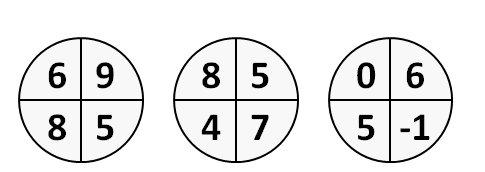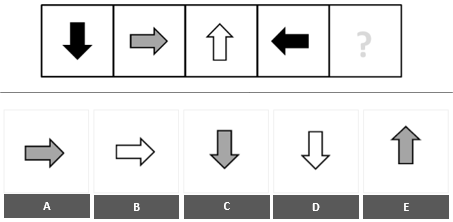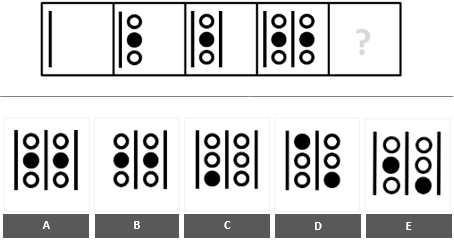Updated November 18, 2025
Prepare for your Cognitive Ability Test with quick interactive simulations and free practice questions.
Start with the timed mini tests at the top of the page and then continue with the sample questions and explanations below.
Question 1 – Verbal Analogy
Find the relationship between the pair of words below, and identify the most similar relationship in the answer options.
REPLETE is to FAMISHED as:
Question 2 – Number Series
Identify the hidden pattern in the series of numbers below, and use it to predict the next/missing number:
8 | 3 | 9 | 10 | 17 | ?
Question 3 – Abstract Reasoning
The numbers in the figures below have the same mathematical relationship to one another.

What number should replace the question mark in the figure below?

Question 4 – Deductive Reasoning
If the first two statements are true, is the final statement true?
Most snakes are green.
Most snakes are quick.
At least one snake is both green and quick.
Question 5 – Numerical Reasoning (Percentages and Word Problems)
If there are 32 students in the classroom and 12.5% of them own at least one pet, how many students do not own any pets?
Question 6 – Verbal Reasoning (Vocabulary)
Clout most closely means -
Question 7 – Numerical Reasoning (Word Problems)
Shelley has 7 dresses, 8 pairs of shoes, and 7 necklaces. If she wears one combination of clothes per day. How many days can she go without wearing the same outfit?
Question 8 – Verbal Reasoning (Synonym / Antonym)
IMPERIOUS is the opposite of:
Questions 2-8 are the type of cognitive questions you will face in the Wonderlic Test. For a full length Wonderlic practice test, click here.
Question 9 – Abstract Reasoning (Spatial)
Which of the following boxes should replace the question mark (?) to complete the pattern?

Question 10 – Logical Reasoning (Syllogism)
Assume the first two statements are true:
All athletes are hard workers.
Alice is not an athlete.
Alice is not a hard worker.
Is the final statement:
Question 11 – Numerical reasoning (Word Problems)
Numerical reasoning - Word Problems
In a popular music station, songs are played fully and uninterrupted (i.e., no commercial breaks).
The popular music broadcast "Hits All Around Us" lasts 2 hours and 15 minutes, in which two-song lengths are played – songs that last 3 minutes and songs that last 6 minutes.
How many songs will be played during the broadcast?
Question 12 – Verbal Reasoning (Sentence Completion)
Choose the word that, when inserted in the sentence to replace the blank, best fits the meaning of the sentence.
Electronic information and automated systems are essential to ____ all major federal operations.
Question 13 – Abstract Reasoning
Which of the following boxes should replace the question mark (?) to complete the pattern?

Question 14 – Letter Series
What would be the next group of letters in the following series?
zone --> ynnd --> xmnc --> wlnb --> ?
Cognitive question examples 9-14 are the type of questions you will encounter in the CCAT Test. To practice more questions, try our Free CCAT Practice Test.
Question 15 – Logical Reasoning (Inferences)
FACTS: If Jason is late to the meeting, Kevin will have to work late. Lois will not cook dinner for Kevin unless Kevin gets home from work on time. If Lois does not cook dinner for Kevin, Kevin will order pizza for dinner. Lois cooked dinner for Kevin.
CONCLUSION: Jason was late to the meeting.
Question 16 – Verbal Reasoning (Odd One Out)
Verbal Reasoning - Odd One Out. In this type of cognitive question, you need to select the word that stands out in regard to its meaning.
Which word does not belong on this list?
Question 17 – Abstract Reasoning (Odd One Out)
Choose the odd one out:

Question 18 – Numerical Reasoning (Word Problems)
Numerical Reasoning - Word Problems
When a smartphone is connected to a charger the battery charge increases by 4.5% per minute. When applications are in use the battery decreases by 3% per 2.5 minutes.
What is the percentage of charging rate per minute if the phone is connected to a charger while several applications are in use?
Question 19 – Logical Reasoning (Assumptions)
- Most technicians work on the first floor.
- All accountants work on the second floor.
- No secretaries work on the third floor.
Conclusion: Rose, a technician, works on the third floor.
If the assumptions are true, is the conclusion:
Question 20 – Abstract Reasoning (Next in Series)
Which block completes the following sequence:


Cognitive questions 15-20 are the types of questions commonly found in the PI cognitive assessment. To practice more questions like these, try our free Predictive Index Practice Test.
What Topics are Included in Cognitive Ability Tests?
Although there is a wide variety of cognitive ability tests that differ in format and difficulty, they generally all set out to measure the same cognitive functions. Each cognitive test is designed to evaluate key areas of intelligence, ensuring the candidate has the necessary skill set for the job.
- Numerical Reasoning: This is the broad term for number-based cognitive skill tests that range from basic math problems to complex numerical problem-solving. A cognitive test might require you to calculate percentages or solve word problems involving numbers.
- Verbal Reasoning: These cognitive tests evaluate your language comprehension through a range of language skills, such as vocabulary, grammar, reading comprehension, and critical reasoning. You might encounter questions that assess how well you understand and process written information.
- Deductive Reasoning: These questions challenge you to deduce conclusions from a set of premises or rules. A cognitive test example might present a set of logical statements and ask you to infer the correct conclusion.
- Logical Reasoning: These questions assess your ability to understand complex texts and apply critical thinking skills to draw conclusions and recognize key facts. Logical reasoning often involves identifying patterns or making connections between different pieces of information.
- Abstract Reasoning: These cognitive tests measure your ability to draw conclusions based on hidden information, often found in symbols or matrices. A cognitive test might ask you to identify a missing piece in a series of shapes or patterns.
To help you prepare for these types of assessments, you can try the free cognitive test above, which will give you valuable practice and insight into how well you perform in each area.
What do Cognitive Ability Tests Measure?
By combining questions of varying complexity from several fields with a stressful time limit, the cognitive ability test challenges the candidate's problem-solving and processing speed abilities.
A cognitive test typically assesses several cognitive functions, such as memory, reasoning, and processing speed. It provides insight into how quickly and accurately you can process information and make decisions. For example, a cognitive test might include questions that require deductive reasoning or logical thinking under pressure.
Cognitive testing is an essential tool in the hiring process because it is one of the most valid predictors of job success. By giving employers a preview of a candidate’s cognitive abilities, the cognitive ability test increases the likelihood that the hiring process will be successful, benefiting both the organization and the candidate. To get a better idea of what to expect, you can try the free cognitive test above to practice before the real thing.
Prepare for your Cognitive Ability Test
Cognitive tests present two major obstacles: short time frames, and questions that include known tricks and distracters. Luckily, you can overcome these two obstacles with the right practice.
JobTestPrep's cognitive test preparation packs offer a comprehensive review of all the question types seen on contemporary employers' cognitive ability tests. Practicing the full range of numerical, verbal, deductive, spatial, and logical reasoning questions under strict time frames can greatly assist in improving your scores.
We also provide detailed answer explanations, helping you to understand the logic behind each question. Furthermore, our insightful score reports can help you assess your own cognitive abilities, strengths, and weaknesses.
Start preparing today with one of our specialized prep packs!
Cognitive Ability Test Scores
Cognitive ability tests measure your cognitive abilities, so how are these scores used to decide which candidate moves forward in the hiring process?
There are two main scoring methods for comparing cognitive ability test results:
- Relative score – your score is placed on a bell curve alongside the scores of other candidates. This allows your score to be compared to others, and a certain cutoff point is set. For instance, an employer might decide that only the top 10% of the scores move on to the next step of the hiring process. Cognitive test examples often use this method to determine which candidates demonstrate the highest levels of cognitive performance.
- Absolute score – the employer sets a specific threshold in advance, and your cognitive ability score must exceed this threshold to proceed. For example, in the Wonderlic test, a candidate might need to answer more than 30 questions correctly to pass.
For more scoring methods, you can observe our ASVAB Scores guide.
The Science Behind Cognitive Ability Tests
Cognitive ability tests are grounded in psychological theories and research that aim to measure key brain functions, helping to understand how well you process information. These cognitive tests assess abilities like memory, processing speed, verbal reasoning, and abstract thinking.
For instance, memory is essential because it enables you to retain and apply information. Processing speed measures how quickly your brain can handle tasks, while verbal reasoning evaluates how well you can comprehend and analyze language, critical skills for communication. Abstract thinking tests your ability to solve novel problems and identify patterns. These cognitive skills are linked to various brain areas, particularly the prefrontal cortex, which plays a central role in decision-making and problem-solving.
By taking a cognitive test practice, you can get a better understanding of how these tests work in practice. To prepare, try the free cognitive test above, which allows you to practice these critical skills and assess your mental agility, an important predictor of success in both professional and academic settings.
Cognitive Ability Testing in the Age of Remote Work
In the post-pandemic era, remote work has become the new norm for many, and as a result, cognitive ability tests are playing a larger role in online job assessments.
Companies increasingly use cognitive tests to evaluate candidates' cognitive skills remotely, helping employers identify individuals who can thrive in digital work environments. The shift to remote work has raised the bar for cognitive flexibility, problem-solving abilities, and self-management skills.
With less direct supervision, employees must adapt quickly, solve problems independently, and stay motivated without constant oversight. Cognitive ability tests are crucial in assessing how well candidates can manage these challenges. They measure critical thinking, adaptability, and decision-making, which are essential for success in remote work settings.
As remote work continues to grow, cognitive ability tests will remain a key tool for employers to ensure they’re hiring individuals capable of thriving in an ever-changing, digital-first work environment.
Tips to Help You Pass Your Cognitive Test
Cognitive tests can be daunting, and the stress that accompanies them due to the high stakes involved can make them even more challenging. However, there are a number of tips and hacks that can help you improve your cognitive ability test score before even beginning to practice!

There will always be a question that you don't get and find yourself wasting time on. You've been asked what "placate" means, and you don’t remember? The best option is to guess and move on, as long as you're confident that guessing won’t result in a point deduction for a wrong answer. Good time management is one of the most vital skills you can practice before the test.

Reading the instructions for each cognitive test question will help ensure you are not missing any important details, preventing you from missing out on points you had in the bag.

The questions in cognitive tests are built to overload your brain. Using a piece of scrap paper to make calculations or visualize a tricky abstract reasoning question can make a big difference.

One of the best ways to prepare for a cognitive ability test is by familiarizing yourself with different question types through regular practice. You can find cognitive test examples above to assess your strengths and weaknesses. Practicing regularly will help you understand the structure and time constraints of the test. Over time, you’ll improve your ability to recognize patterns, work more efficiently under pressure, and sharpen your problem-solving skills. It’s essential to practice a variety of cognitive tests, from verbal reasoning to numerical and abstract reasoning, to ensure you're well-prepared for whatever comes your way during the actual test. This consistent practice builds confidence, reduces test anxiety, and ultimately improves your test performance.
Create Your Own Assessment Prep Kit!
Finding a job can be a lengthy and challenging journey, often stretching over months and requiring multiple pre-employment tests and interviews. With our Premium Membership, you'll have the support you need every step of the way.
Mix & match 3 Preparation Packs at 50% discount for 1,3, or 6 months
FAQs
A Cognitive Ability Test is designed to measure your reasoning, problem-solving skills, and overall mental agility. Employers use these tests to evaluate how well you can learn, process information, and handle complex tasks. Performing well on these tests can increase your chances of progressing in the hiring process and demonstrate your potential to succeed in a role.
Our prep course is designed to help you understand the test format, the types of questions you'll encounter, and the timing strategies necessary for success. Through a mix of practice tests, detailed explanations, and targeted study tips, you will build confidence and identify areas where you can improve. This focused preparation will sharpen your cognitive skills and enhance your overall test-taking performance.
The preparation materials encompass various topics typically featured in Cognitive Ability Tests, such as numerical reasoning, verbal reasoning, abstract reasoning, and logical problem-solving. You will find practice questions that resemble actual test items, accompanied by step-by-step solutions to help you grasp the underlying concepts and methods for solving similar problems.
The course is organized into distinct modules, each concentrating on different aspects of cognitive testing. It features interactive lessons, practice exercises, and full-length simulated tests to help you monitor your progress. While study time can vary based on your starting level, many users find that committing a few hours each week over several weeks is enough to achieve significant improvements.
We offer free sample materials and trial options so you can experience the quality and structure of our prep course before making a purchase. These samples give you a preview of our comprehensive approach, helping you decide if the course meets your learning style and preparation needs.
A cognitive ability test evaluates various mental skills that are crucial for problem-solving and decision-making in the workplace. It assesses abilities such as numerical reasoning, verbal comprehension, abstract thinking, logical thinking, and the capacity to learn and adapt quickly. By understanding what these tests measure, you can focus your preparation effectively and enhance your performance on the actual exam.
Our cognitive ability test preparation program is designed to help you succeed on exams that commonly assess five key areas:
- Numerical Reasoning: Measures your ability to work with numbers and interpret data.
- Verbal Reasoning: Evaluate your understanding of language, including reading comprehension and vocabulary.
- Abstract Reasoning: Assesses your ability to identify patterns, logical rules, and trends in data.
- Logical Reasoning: Tests your capability to analyze situations and draw logical conclusions.
- Spatial Reasoning: Measures your ability to visualize and manipulate objects in space.
This program aims to enhance your performance in these critical areas, ensuring you are well-prepared for your assessments.
The 30-question cognitive test is a practice assessment designed to simulate the actual testing environment in a shorter format. It offers a quick yet comprehensive overview of the types of questions you will encounter, helping you gauge your current abilities and identify areas for improvement. This condensed test is ideal for familiarizing yourself with the timing, question structure, and overall challenges of cognitive ability assessments.
Looking to practice a specific test? Check out our exams below:
ATSA Test | CAST Test | Free Civil Service Exam | Free CritiCall Test | Firefighter Test | FEAST I Air Traffic Test | Free IBEW Test | Free NYPD Exam | Free Pymetrics Practice Test | Free Police Written Exam | Free TSA CBT Test | Free WorkKeys Test | HireVue | Indeed Assessments Test | Korn Ferry Assessments | P&G Practice Tests | PI Cognitive Assessment | USPS Postal Exam (474 - 477) | Watson Glaser Test
Join over 2,700 candidates who have boosted their cognitive skills with our proven strategies.




